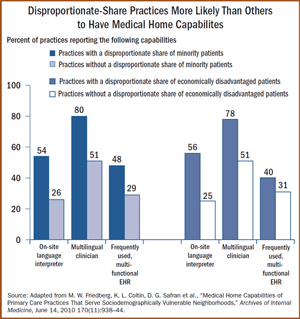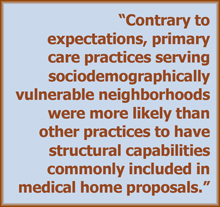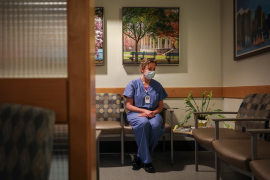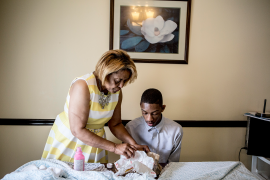Synopsis
A survey of primary care practices in Massachusetts that serve neighborhoods with high percentages of racial and ethnic minorities or economically disadvantaged residents found these practices were more likely than others in the state to have several key components of medical homes, including on-site language interpreters, clinicians who speak multiple languages, and frequently used, multifunctional electronic health records.
 The Issue
The Issue
Under current and planned medical home pilot projects around the country—including an upcoming Medicare demonstration—practices that are designated as medical homes may qualify for enhanced payments. Practices may be unable to qualify for these payments, though, if they do not have certain structural capabilities in place, like enhanced access to care (e.g., evening and weekend appointments), reminder systems for patients and providers, and electronic health records. For many practices serving poor and underserved neighborhoods, the cost of developing such capabilities can be a high barrier—making it even more difficult for residents to gain access to a medical home. Researchers surveyed primary care practices in Massachusetts to assess their possession and use of medical home capabilities, and compared practices disproportionately serving minority and low-income neighborhoods with other practices.
Key Findings
- Practices serving neighborhoods with disproportionately high percentages of racial and ethnic minorities or economically disadvantaged residents were significantly more likely than others to have on-site language interpreters; clinicians who speak multiple languages; and frequently used, multifunctional electronic health records. (See exhibit.)
- Minority disproportionate-share practices were also more likely to have staff who assist patients in self-managing chronic illnesses. Economic disproportionate-share practices were more likely to report that physicians were aware of patients' ratings of their health care experiences.
- None of the 13 structural capabilities the researchers examined was less likely to occur in practices disproportionately serving vulnerable neighborhoods than in other practices.
Addressing the Problem
 The study's findings ran contrary to the researchers' original expectations, suggesting that disproportionate-share practices may not face especially high barriers in qualifying for enhanced medical home payments. The researchers note, however, that for some medical home capabilities, including electronic health records, the association with disproportionate-share status was mediated by larger practice size—meaning that these associations may not apply to parts of the country where disproportionate-share practices are smaller than other practices. Still, the positive association between practice sites' language capabilities and disproportionate-share status was independent of practice size, suggesting that practices serving vulnerable populations may especially benefit from the inclusion of language capabilities in official definitions of the medical home.
The study's findings ran contrary to the researchers' original expectations, suggesting that disproportionate-share practices may not face especially high barriers in qualifying for enhanced medical home payments. The researchers note, however, that for some medical home capabilities, including electronic health records, the association with disproportionate-share status was mediated by larger practice size—meaning that these associations may not apply to parts of the country where disproportionate-share practices are smaller than other practices. Still, the positive association between practice sites' language capabilities and disproportionate-share status was independent of practice size, suggesting that practices serving vulnerable populations may especially benefit from the inclusion of language capabilities in official definitions of the medical home.
About the Study
The authors surveyed 308 primary care practices in Massachusetts from May to October 2007, asking a physician at each site to report on 13 capabilities commonly used to define a medical home. The capabilities fell into four domains: patient assistance and reminders, culture of quality, enhanced access, and electronic health records. The authors used patients' zip codes and U.S. Census data to determine the prevalence of minority and economically disadvantaged residents served by each practice.
The Bottom Line
Contrary to expectations, primary care practices that serve sociodemographically vulnerable neighborhoods were more likely than other practices to have key medical home components in place.


